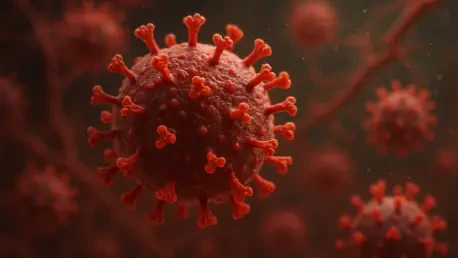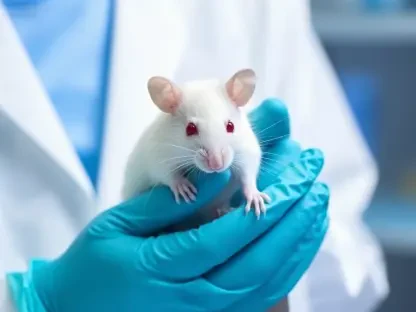In the bustling economic hub of Nanjing, China, located in the heart of the Yangtze River Delta, a pressing public health challenge has emerged with the rapid spread of HIV-1 CRF119_0107, a second-generation recombinant strain derived from CRF01_AE and CRF07_BC. This variant has climbed to become the third most prevalent HIV-1 strain in the region, highlighting the growing complexity of the epidemic in urban centers. Between 2019 and 2024, prevalence rates among newly diagnosed cases have surged from 3.2% to 7.8%, signaling an urgent need for targeted interventions. Nanjing, the capital of Jiangsu Province, carries a significant HIV burden, particularly among men who have sex with men (MSM), who are the primary drivers of this strain’s transmission. The intricate interplay of demographic, behavioral, and geographic factors has fueled its dissemination across the city’s 12 districts. By leveraging genomic and spatial epidemiology, researchers have gained critical insights into hidden transmission networks and high-risk areas, revealing both the scope of the challenge and potential pathways for control. This alarming trend, compounded by a high rate of transmitted drug resistance (TDR) at 15.9%, poses a substantial threat to the effectiveness of standard antiretroviral therapy (ART), demanding innovative strategies to curb its spread.
Unraveling Transmission Patterns
Demographic Vulnerabilities in MSM Communities
The spread of HIV-1 CRF119_0107 in Nanjing is predominantly driven by MSM, with 84.8% of the 138 studied cases linked to homosexual contact, reflecting a deeply rooted epidemic within this group. The typical demographic profile reveals young men, averaging 26.5 years of age, largely unmarried, and often college-educated, comprising 75.4% of those affected. This suggests that specific social environments, such as university campuses and urban social venues, may act as key hubs for transmission. Despite their education levels, which might imply greater awareness of HIV risks, high-risk behaviors like unprotected sex and multiple partnerships persist. Stigma surrounding sexual orientation and limited access to tailored prevention programs likely contribute to this disconnect, allowing the virus to proliferate within tight-knit social and sexual networks. Addressing these gaps requires culturally sensitive outreach that resonates with this demographic, focusing on safe practices and reducing barriers to testing and care.
Beyond individual behaviors, the structure of MSM networks in Nanjing amplifies the rapid dissemination of CRF119_0107. Dense social connections, often facilitated by dating apps and community gatherings, create ideal conditions for the virus to spread quickly among young men. The high proportion of unmarried individuals in this group—86.2%—further indicates a lifestyle that may prioritize casual encounters over long-term partnerships, increasing exposure risks. Public health efforts must prioritize education campaigns in digital and physical spaces where these networks thrive, alongside fostering environments that encourage open discussions about sexual health. Partnerships with community organizations could enhance trust and improve uptake of preventive measures like pre-exposure prophylaxis (PrEP), which remains underutilized in this population. Without such targeted interventions, the epidemic within MSM communities risks continued escalation.
Signs of Broader Population Impact
While MSM remain the epicenter of CRF119_0107 transmission, a concerning trend of spread into heterosexual populations has emerged, with 14.5% of cases now attributed to both commercial and non-commercial heterosexual contact. This shift suggests the presence of bridging mechanisms, where key individuals—possibly those engaging in bisexual behavior or commercial sex—link disparate risk groups. The integration of heterosexual individuals into clusters predominantly composed of MSM points to complex sexual networks that transcend traditional boundaries. If unchecked, this crossover could significantly expand the epidemic’s reach, affecting broader segments of Nanjing’s population. Surveillance systems must adapt to capture these cross-population dynamics, ensuring that prevention efforts are not narrowly focused but encompass a wider array of risk settings.
To address this evolving threat, public health strategies in Nanjing need to extend beyond MSM-focused initiatives and include testing and education programs targeting heterosexual communities, especially in high-risk environments like entertainment districts. The potential role of commercial sex as a transmission bridge underscores the importance of outreach to sex workers and their clients, offering accessible testing and counseling services. Moreover, identifying and supporting individuals who connect different risk groups could disrupt these transmission chains before they widen. Collaborative efforts between health authorities and local organizations are essential to implement these broader measures, ensuring that resources are allocated effectively to prevent a larger outbreak. The urgency of adapting to these emerging patterns cannot be overstated, as delayed action might lead to a more entrenched and diverse epidemic.
Genomic and Spatial Dimensions of the Epidemic
Clustering Trends and Network Activity
Molecular network analysis has revealed a striking clustering rate of 56.6% for CRF119_0107, with 78 out of 138 genetic sequences forming 11 distinct transmission clusters in Nanjing. This rate surpasses that of other dominant HIV-1 strains in the region, such as CRF01_AE at 46.4%, underscoring the active and rapid dissemination of this particular variant. The presence of four large clusters, which account for 70.6% of clustered individuals, illustrates the concentration of transmission within specific networks, predominantly among MSM but also incorporating heterosexual cases. These findings highlight the virus’s ability to exploit dense social connections, creating hubs of infection that fuel its spread. Public health responses must focus on mapping these networks to identify central nodes for intervention, preventing further expansion of these clusters.
The dynamic nature of these clusters adds another layer of complexity to controlling CRF119_0107’s spread across Nanjing. Two specific clusters have shown significant growth, adding over two nodes annually in recent years, indicating sustained transmission risk within these groups. In contrast, stable clusters have exhibited no growth since earlier periods, likely due to timely ART initiation that suppresses viral loads and halts further spread. This dichotomy emphasizes the importance of rapid identification and treatment of newly diagnosed cases to stabilize active clusters. Resources should be directed toward real-time monitoring of high-growth networks, ensuring that health workers can intervene promptly with counseling and therapy. Such targeted actions are vital to breaking the chains of transmission and reducing the overall clustering rate in the city.
Geographic Spread Across Urban Districts
Spatially, CRF119_0107 is not confined to isolated pockets but is distributed across all 12 districts of Nanjing, reflecting the pervasive nature of the epidemic in this urban center. Notably, transmission frequently occurs between districts, even those not geographically adjacent, with inter-district links accounting for 83.9% of all transmission connections. This pattern points to the significant role of mobility and social connectivity in modern urban settings, where individuals move freely for work, education, or social interactions. Districts like Lishui, with an exceptionally high clustering rate of 81.3%, emerge as critical hotspots requiring focused attention. The random spatial distribution, lacking significant autocorrelation, further complicates localized control efforts, as transmission does not follow predictable geographic patterns.
The extensive inter-district transmission of CRF119_0107 necessitates a coordinated, regional approach to public health interventions in Nanjing. Strong connections between non-adjacent areas, such as Qixia and Lishui, suggest that social networks and travel patterns override physical boundaries, driving the virus’s spread. This interconnectedness means that isolated, district-level responses are insufficient; instead, health authorities must foster collaboration across jurisdictions to share data and resources. Joint initiatives could include mobile testing units and awareness campaigns that target transient populations or high-traffic areas. By addressing the geographic fluidity of transmission, such strategies can better contain the epidemic, ensuring that interventions are as dynamic as the mobility patterns fueling the virus’s dissemination.
Addressing Drug Resistance and Public Health Challenges
Rising Threat of Treatment Resistance
One of the most alarming aspects of CRF119_0107 in Nanjing is the high rate of transmitted drug resistance (TDR), recorded at 15.9%, which far exceeds both local and national averages for HIV-1 strains. This resistance primarily targets non-nucleoside reverse transcriptase inhibitors (NNRTIs), a cornerstone of first-line ART regimens, with the K103N/KN mutation being the dominant factor. Found in a growing cluster of 19 individuals, this mutation renders drugs like efavirenz and nevirapine largely ineffective, posing a direct threat to treatment success. The elevated initial viral loads among TDR-affected individuals, coupled with their increased likelihood of clustering, heighten the risk of propagating resistant strains across networks. This situation underscores a critical vulnerability in current treatment protocols, demanding immediate action to safeguard therapeutic outcomes.
Mitigating the impact of TDR associated with CRF119_0107 requires a multifaceted approach that prioritizes early detection and alternative treatment options in Nanjing. Real-time surveillance of drug-resistant clusters can provide timely data on emerging resistance patterns, enabling health officials to adjust strategies accordingly. Individuals with TDR often face a higher risk of treatment failure, which not only affects their health but also perpetuates the cycle of transmission. Implementing rapid ART initiation, ideally within 30 days of diagnosis, alongside enhanced viral load monitoring, can help suppress viral replication early on. These measures, combined with increased access to comprehensive resistance testing, are essential to prevent the further spread of resistant variants and maintain the effectiveness of HIV management programs in the region.
Strategic Responses to Resistance Challenges
Combating the TDR challenge linked to CRF119_0107 involves adopting innovative therapeutic regimens that circumvent the limitations of current first-line treatments in Nanjing. The World Health Organization (WHO) recommends shifting to dolutegravir (DTG)-based regimens for cases with confirmed resistance to NNRTIs, as these alternatives offer greater efficacy against resistant strains. Transitioning to such therapies could significantly reduce the risk of treatment failure and subsequent transmission of resistant variants. However, this shift requires robust healthcare infrastructure to ensure drug availability and patient adherence, alongside training for medical staff to manage these updated protocols. Investments in medical insurance and funding are crucial to support access to diverse treatment options, addressing disparities that might otherwise hinder effective care.
Beyond clinical adjustments, strategic public health interventions must focus on preventing the emergence and spread of resistant CRF119_0107 strains through community-level actions in Nanjing. Strengthening PrEP programs for high-risk individuals can serve as a preventive barrier, reducing new infections that might carry resistant mutations. Additionally, intensified case management for those lost to follow-up ensures continuity of care, minimizing opportunities for untreated individuals to transmit resistant viruses. Collaborative efforts between local health departments and national programs can facilitate the integration of these strategies, aligning with global targets to reduce HIV incidence and mortality by 2030. By combining clinical innovation with proactive prevention, the impact of drug resistance on Nanjing’s HIV epidemic can be significantly curtailed, protecting both current and future generations.
Reflecting on Past Efforts and Future Directions
Lessons from Recent Epidemic Management
Looking back, the management of HIV-1 CRF119_0107 in Nanjing over the past several years revealed critical gaps in early detection and intervention that allowed the strain to gain a foothold among MSM populations. Initial underestimation of the strain’s rapid clustering and high TDR rate delayed the implementation of tailored responses, enabling transmission networks to expand unchecked. Efforts to focus solely on localized districts often fell short due to the extensive inter-district connectivity that characterized the epidemic’s spread. While ART initiation proved effective in stabilizing some clusters, inconsistent access to timely treatment for all newly diagnosed cases hindered broader success. These challenges highlighted the necessity of integrating genomic and spatial data to inform real-time decision-making, a lesson that shaped later improvements in surveillance practices.
Another key reflection from past approaches was the insufficient attention to cross-population transmission dynamics, which allowed CRF119_0107 to begin affecting heterosexual groups. Limited outreach to diverse risk settings, coupled with stigma-driven barriers to testing among MSM, compounded the difficulty of containing the virus. Public health campaigns that lacked cultural sensitivity failed to resonate with vulnerable demographics, missing opportunities to curb high-risk behaviors. The high prevalence of drug resistance also exposed vulnerabilities in relying heavily on NNRTI-based regimens without adequate resistance monitoring. These experiences underscored the importance of adaptive, inclusive strategies that evolved with the epidemic’s changing patterns, informing more robust frameworks for response in subsequent efforts.
Building a Path Forward for Control
Moving ahead, Nanjing’s battle against HIV-1 CRF119_0107 demands a forward-thinking strategy that builds on past lessons to prioritize precision public health interventions. Establishing a city-wide surveillance network that integrates real-time genomic and spatial data can pinpoint high-growth clusters and resistance hotspots for immediate action. Expanding access to DTG-based ART regimens, alongside ensuring rapid treatment initiation within 30 days of diagnosis, should form the backbone of clinical responses to tackle TDR. Regional collaboration across districts must be strengthened through shared information systems and joint initiatives, addressing the extensive inter-district transmission that defines this epidemic. Allocating resources to mobile testing units and digital outreach can enhance early detection, particularly among mobile and hard-to-reach populations.
Equally critical is the expansion of prevention programs tailored to both MSM and emerging heterosexual risk groups, incorporating PrEP and comprehensive sexual health education to disrupt transmission bridges. Partnerships with community organizations can rebuild trust and improve engagement with stigmatized populations, ensuring that interventions are culturally relevant and accessible. Increased funding for medical insurance will be essential to support diverse treatment options and sustained care for those lost to follow-up. By aligning these efforts with global health targets, such as those set by UNAIDS for 2030, Nanjing can optimize resource allocation to reduce incidence and mortality. These actionable steps offer a roadmap to not only contain CRF119_0107 but also fortify the city’s defenses against future HIV challenges, paving the way for a healthier urban population.









